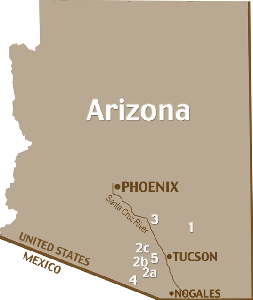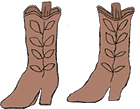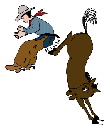


 |
 |
|
 |
||
 |
REDINGTON SCHOOL (Number 1 on the map)
Redington School was located on the Carlink Ranch in the lower San Pedro River valley in Pima County, 75 miles northeast of Tucson. It was an accommodation school for the children of families living on the remote ranches in the area. When Eulalia Bourne arrived in the fall of 1930, none of the Redington students had ever saluted the flag, memorized a poem, had a book read to them, listened to music in the schoolroom, given a community entertainment, or gone on a school expedition to the outside world. Nobody could read. But they all wanted to learn, and learn they did. The first Little Cowpuncher appeared there in November, 1932, written and illustrated by the entire student body of seven boys and four girls. The name of the paper was the idea of one of the students, Gareth Bingham. |
||
 |
BABOQUIVARI SCHOOL (Numbers 2a, 2b and 2c on the map)
Baboquivari (bah-bow-KEE-vahr-ee) School had three different locations during its time as a Little Cowpuncher school. All were in Pima County and within 25 miles of each other. The first issue appeared in October, 1935 at Pozo Nuevo Ranch (2a), see a hand-drawn picture of the school, in the Altar Valley, 50 miles south of Tucson, near the Mexican border. The student body consisted of the nine Aros children, who lived on the ranch, and ten others who were bussed in from long distances. Only a few of them knew how to read before Eulalia Bourne arrived. Bill Ronstadt, owner of the nearby Delicias Ranch, and Pascual Hernandez, the bus driver, were the only members of the school board. However, in the fall of 1937, because their noise and activity were disturbing the horses and cattle, the school had to find a new location. In November, 1937 Baboqivari School moved a few miles away to Espinosa Ranch (2b). There the students were divided into two small rooms, with Eulalia Bourne running between the younger and older students. Only the girls had a toilet; the boys used the bushes. That school year, Baboquivari School printed and passed out the February issue of Little Cowpuncher while riding on a float in the Tucson Rodeo Parade. In September 1938, the school moved again, this time to Palo Alto Ranch (2c), 38 miles southwest of Tucson. However, Eulalia Bourne was absent that fall. Two substitute teachers filled in for her, so she could live on, and secure, her homestead claim. Eulalia wasn't able to return until after the Christmas vacation. The first Little Cowpuncher created at Palo Alto Ranch was the February 1939 Rodeo Issue, which was published in the Arizona Daily Star. Regular issues of Little Cowpuncher appeared from March to May, 1939. |
||
 |
SASCO SCHOOL (Number 3 on the map)
Sasco Ranch School was the only Little Cowpuncher school not in Pima County. It was located seven miles from Red Rock in southern Pinal County, about 35 miles northwest of Tucson on Rafael Tapia's ranch and neighbor to the La Osa Livestock Co.. There were 21 students the year Eulalia Bourne taught there. She painted the school and blackboards herself, and had to wait several months for a teacher's quarters to be built onto the school. Little Cowpuncher came out from November, 1939 to May, 1940. See a hand-drawn picture of the school. |
||
 |
SAN FERNANDO SCHOOL (Number 4 on the map)
San Fernando School was the largest of the Little Cowpuncher schools. It was located at Sasabe, in southernmost Pima County, on the Mexican border, and 95 miles south of the Sasco school. Built on a hill, it had a large playground with swings and "Johny Strikes." There were 30 students in two classrooms taught by two teachers, Eulalia Bourne and Mr. O.C. Arnold. Little Cowpuncher appeared there from October, 1940 to May, 1941; and again from October, 1942 to May, 1943. See a hand-drawn picture of the school |
||
 |
SOPORI SCHOOL (Number 5 on the map)
Sopori School (SOE-poe-ree) was located in Pima County. It was on Sopori Creek, west of the Nogales Highway, 45 miles south of Tucson, on the Arivaca Road. Little Cowpuncher was produced there from November, 1941 until May, 1942. Sopori School was probably the best equipped of all the Little Cowpuncher schools. Built in 1927, it consisted of one large classroom that could be divided with folding panels, 2 bathrooms, supply room, sewing room, and teacher's quarters. Outside there was a flagpole. During its year as a Little Cowpuncher school, money was collected for a piece of playground equipment, a "Johnny Strikes" or "Giant Strides" that the students helped to install. In 1941 Sopori School had 27 students: "10 Nordic-Americans and 17 Mexican-Americans" as Eulalia Bourne described them. |


